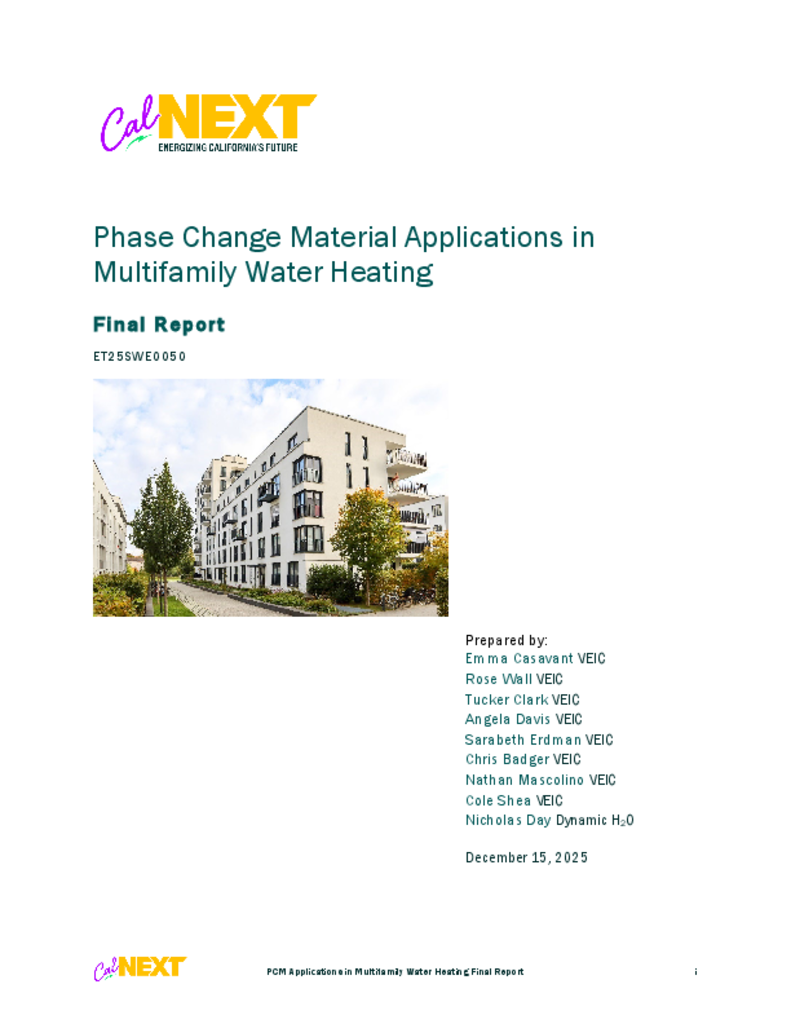ET25SWE0050 - Phase Change Material Applications in Multifamily Water Heating
This project assesses the application, market opportunity, and performance of phase change material (PCM) thermal energy storage systems (TESS) to replace inefficient gas and electric water heaters located in space-constrained California multifamily buildings, or as a technology solution to reduce or eliminate recirculation losses in shared systems. Although not the primary focus of this project, the findings can be applied to single-family residences and manufactured homes with similar constrained water heater locations or recirculation systems.
PCM thermal storage systems offer up to four times the energy storage density of traditional tanks and are compatible with solar thermal, heat pumps, and off-peak electric heating. PCM water heaters store and release energy by transitioning between solid and liquid phases, delivering performance comparable to tankless systems and supporting long-duration hot water needs.
An assessment of PCM TESS applications in residential water heating will address several market barrier such as the absence of technical design and analysis for incorporating PCM water heating solutions to reduce recirculation and distribution losses; the physical limitations that prevent the installation of integrated heat pump water heaters (HPWHs); the performance challenges HPWHs face in recirculation systems; the lack of awareness and inclusion of PCM technologies in incentive programs; and the difficulty of deploying advanced systems during emergency replacements or in do-it-yourself (DIY) scenarios. This research will include detailed market and technical analysis of existing PCM solutions, direct stakeholder interviews, cost analysis, engineering review, and building energy modeling to qualify the pathway and impact of utilizing PCM thermal storage to maximize efficiency and reduce costs in decarbonizing California's multifamily water heating.
This project will leverage active CalNEXT program studies researching the market opportunity for split-system HPWHs to address limitations of integrated HPWHs, as well as CalNEXT research on the applications of central HPWHs (CHPWH) and recirculation optimization in multifamily buildings.
While PCM TESS is gaining traction in HVAC and commercial sectors, residential water
heating applications remain nascent. High first costs, installer unfamiliarity, and lack of
standardized data limit adoption. At the same time, California’s multifamily buildings
face complex challenges in transitioning to low-carbon domestic hot water (DHW)
systems, especially in retrofit scenarios where space, cost, and distribution inefficiencies
limit electrification. This CalNEXT technology development study introduces a novel
design: integrating Phase Change Material Thermal Energy Storage Systems (PCM TESS)
into central DHW systems to enable more cost-effective and space-efficient central heat
pump water heater (CHPWH) upgrades. This design reduces distribution losses, supports
load shifting, and minimizes the need for large central storage tanks by repurposing
existing recirculation infrastructure into a PCM charging loop. This report presents
initial engineering designs, energy modeling results, and stakeholder feedback to inform
future lab testing and field demonstrations.
The volume of central storage required for load shifting in typical CHPWH designs,
combined with the need for swing tanks to manage recirculation loads, often creates
challenges for buildings with space-constrained mechanical rooms. These components
can increase first costs and reduce overall system performance. The proposed
distributed PCM system design addresses cost and system performance issues created by
the need for swing tanks and by existing mechanical room space constraints by
repurposing distribution and recirculation piping into a PCM charging loop. This
eliminates the need for swing tanks and reduces central storage volume by up to 67%.
Energy modeling of the PCM design shows a 26% reduction in heat loss from central
recirculation systems and an 8% reduction in overall DHW load. For CHPWH
applications, load shifting enabled by PCM TESS can yield cost savings under time-of-use
(TOU) rates, despite slightly higher energy use due to reduced central plant efficiency.
These findings indicate that PCM TESS offers a viable pathway to expanding uptake and
performance of CHPWH systems in California’s multifamily buildings. Building on these findings, this study outlines a roadmap for further engineering development, field
validation, and market adoption of PCM TESS

